The ARM vs x86 Wars Have Begun: In-Depth Power Analysis of Atom, Krait & Cortex A15
by Anand Lal Shimpi on January 4, 2013 7:32 AM EST- Posted in
- Tablets
- Intel
- Samsung
- Arm
- Cortex A15
- Smartphones
- Mobile
- SoCs
Cortex A15: Kraken
While SunSpider wasn't a great performance target for Exynos 5250, Kraken is a different story entirely. The Cortex A15s complete the task significantly quicker than the competition, and as a result achieve competitive energy usage although at significantly higher peak power consumption.
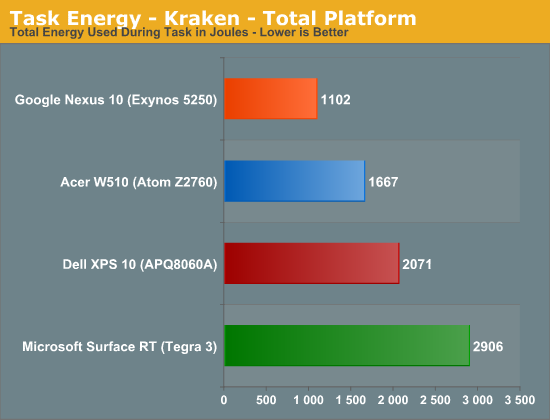
Despite the high peak power consumption of the Nexus 10 and its Cortex A15s, total energy usage is the lowest out of any of the contenders here since the Exynos 5250 is able to complete the benchmark so quickly. Intel is up next, followed by Qualcomm.
Once again we're seeing peak CPU power usage of ~3W, compared to < 1.5W for the competition. The performance advantage is enough to justify the added power, however in devices that simply can't dissipate this much heat (e.g. smartphones) I wonder what will happen.

Isolate the CPU cores themselves and the race is much closer, this time with Qualcomm taking the lead.
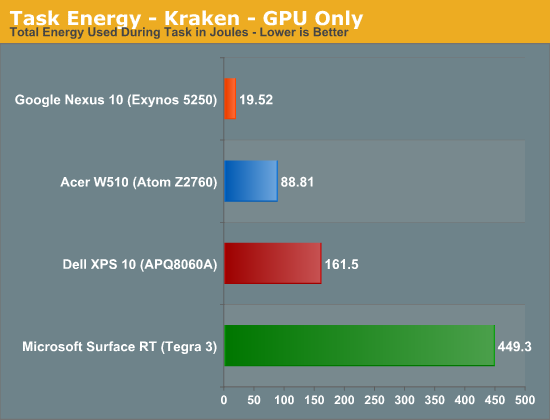
When mostly idle, the Mali-T604 on Samsung's 32nm LP (HK+MG) process barely sips power.
Kraken - Max, Avg, Min Power
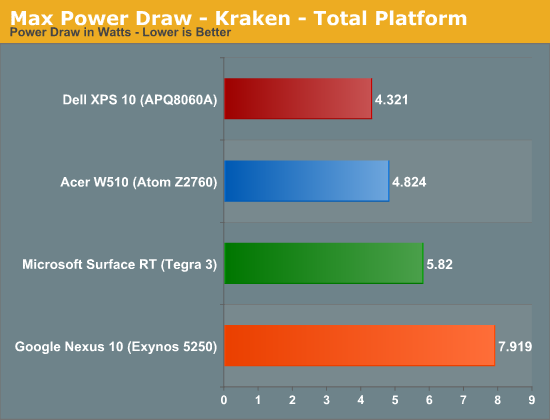
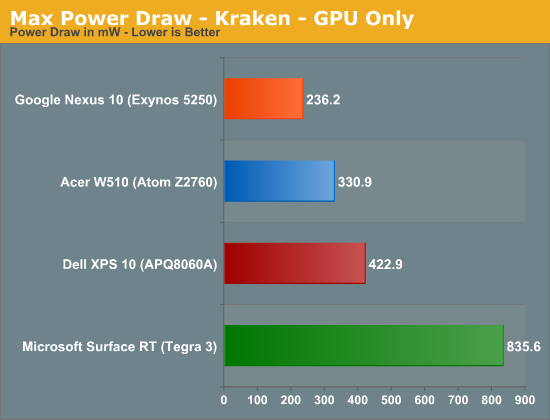
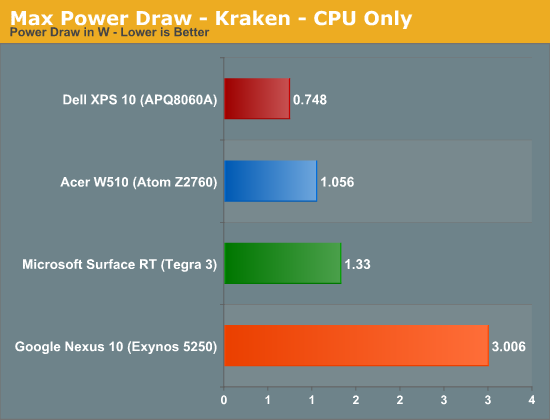
Average Power Draw
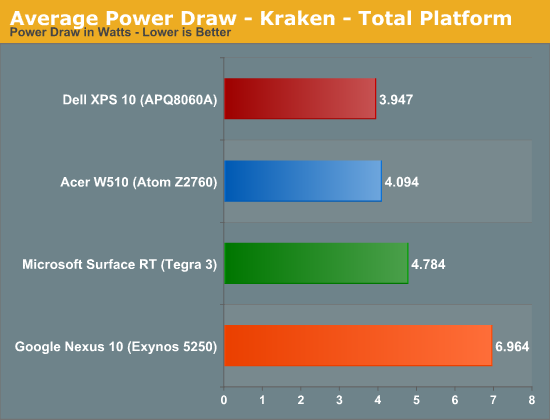
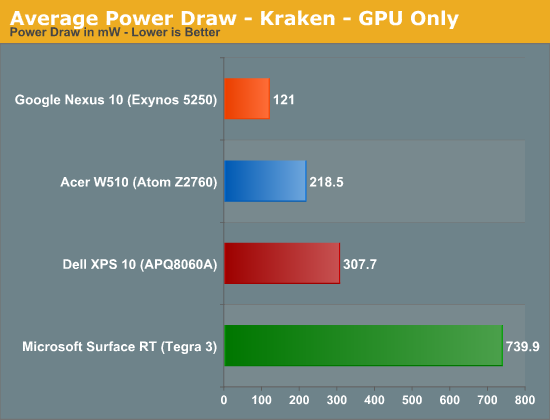

Minimum Power Draw

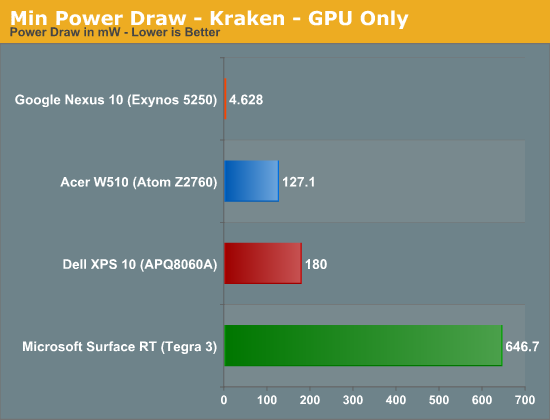
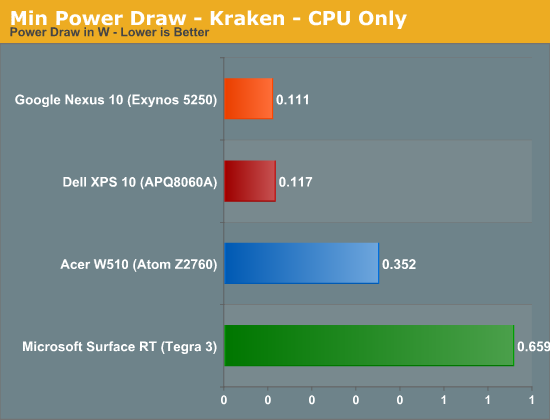


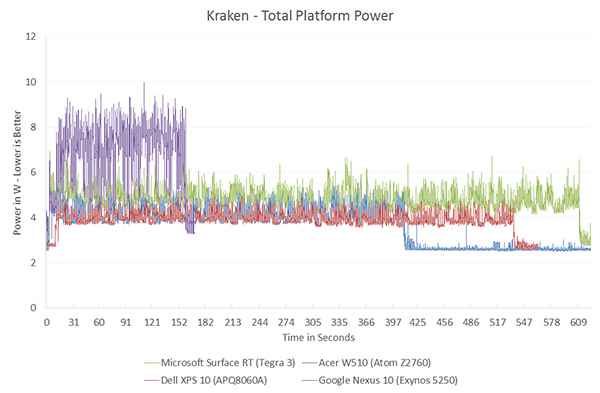
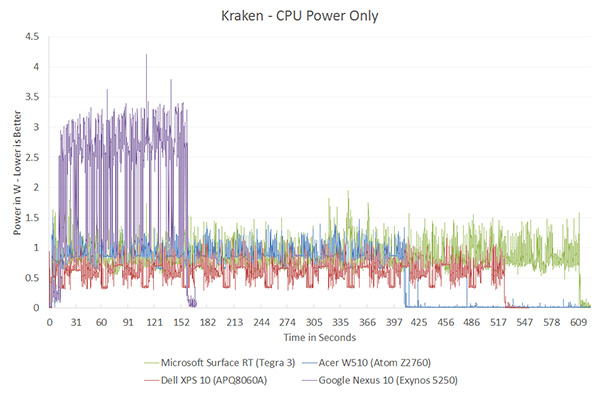
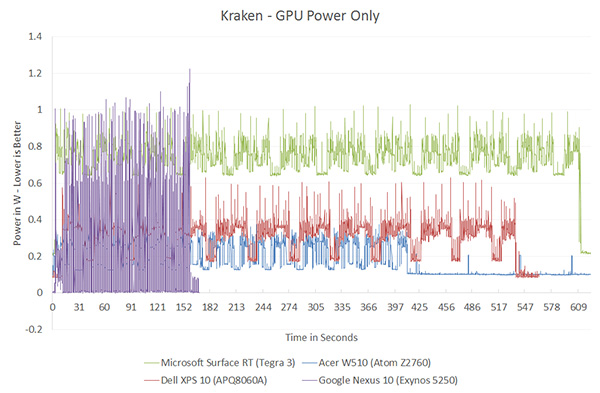








140 Comments
View All Comments
extide - Friday, January 4, 2013 - link
When will you post an article about Bay Trail / Valley View?? Usually you guys are pretty fast to post stuff about topics like this yet I have seen some info on other sites already...jpcy - Friday, January 4, 2013 - link
...which I bet CISC users thought had ended about 18 years ago...It's good to see a resurgence of this highly useful, extremely low-power and very hardy British CPU platform.
I remember back in the day when ARMs were used in the Acorn computers (possibly too long ago for most to remember, now - I still have an A7000 and a RISC PC with both a StrongARM and a DX2-66 lol) was at war with Intel's Pentium CPU range and AMD's K6's, boasting an almost 1:1 ration of MIPS:MHz - Horsepower for your money (something Intel and AMD were severely lacking in, if I remember correctly.)
And now, well, who'dve thought it... These ARM CPUs are now in nearly everything we use... Phones, smartphones, tablets, notebooks...
Suppose I was right in the argument with my mate in school afterall... RISC, superior technology (IMHO) may well take over, yet!
nofumble62 - Friday, January 4, 2013 - link
No performance advantage, no battery life advantage. Why anyone would bother with incompatible software?sseemaku - Friday, January 4, 2013 - link
Looks like people have changed religion from AMD to ARM. Thats what I see from some comments.mugiebahar - Saturday, January 5, 2013 - link
Yeah n no. They wanted a no paid opinions to screw with the outcome. But Intel hype won over real life .Intel better and will get better - yes
Any chance they will compete (performance and PRICE) and legacy. Support to phone apps - Never in the near future which is the only time for them.
tuxRoller - Saturday, January 5, 2013 - link
Also, any chance for an actual performance comparison between the platforms?Apple's performance and power use look awesome. Better than I had imagined.
I'd love to see how they compare on the same tests, however.
Kogies - Saturday, January 5, 2013 - link
It appears the war has begun, well two wars in fact. The one you have articulately described, and the oft ensuing war-of-words...Thanks Anand, I appreciate the analysis you have given. It is excellent to get to see the level of granularity you have been able to achieve with your balance of art and science, and knowing where to hook into! I am very interested to see how the L2 cache power draw effects the comparison, just a little jitter in my mind. If nothing else, it looks as if the delicate balance of process tech., and desired performance/power may have a greater bearing on this "war" than mere ISA.
With Krait 300, Haswell, and more A15's this is going to be a tremendous year. Keep up the good work.
Torrijos - Saturday, January 5, 2013 - link
Any chance we could see the same tests run on the latest Apple iPad?That way we could have a chance to see what Apple tried to improve compared to the A15 generation.
urielshun - Saturday, January 5, 2013 - link
The whole discussion about ARM and x86 is not important when you go for the ecomonics of each platform. ARM is dirty cheap and works well. It's 1/10th of the price of any current Atom with decent perfomace (talking about RK3066).Don't underestimate the Chinese they are having a field day with ARM's pricing model and and have shown amazing chips.
In 8 years from now all SoC's would have reached the usuable performace and the only thing that will matter will be power and cost of integration.
iwod - Saturday, January 5, 2013 - link
Where are you getting 1/10 of a price from? Unless they are produced on good old 40nm LP Node with Nothing else, or crap included, otherwise there just aren't any Chinese SoC selling for $4